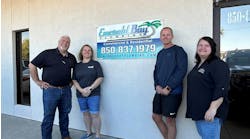Today's plumbing and heating business is peppered with “old solar guys” who were just coming of age when solar hit big in the late 1970s and early 1980s. They not only remember how it was, they also paved the way to where the industry is today with improved products and installations. They are the guys who stayed with it for the past 25 years, fine tuning the many systems that are still running.
What happened to solar the first time around? Where did the industry go? That early solar boom was primarily the result of the 1970s energy crisis. The solar boom was driven by combined federal and state tax credits of up to 70% of the cost of an installation with a cap of $10,000. This was intended to help Americans gain energy independence. But when the credits disappeared, so did the solar heating business.
Unfortunately, the tax credits made solar an easy proposition for the salesmen whom some in the business referred to as “dog catchers and used car salesmen.” These non-technical people often sold on unsubstantiated claims, provided shoddy workmanship and too frequently skipped out on systems that simply could not work.
Back then, on the equipment side of things, each system had to be custom-designed and built of individual pieces of equipment. Controls were borrowed from the traditional heating industry. There were some serious “bugs” in the first generation equipment, such as the drain-down spool valve that became known as the freeze-down valve.
Another problem was the “ugly factor.” People weren't always pleased with the look of tilted-up roof panels. When they re-roofed, there was the chance that the panels would not be put back because the owner didn't know if the solar equipment was still operational or worth the clutter on the roof.
Yet the energy savings were there. According to Steve Ruby, principal of Aqua Care of Boulder, Colo., it is estimated that a utility bill savings of 60-70% really did come from systems designed with the F-Chart (solar fraction) calculation. Included in this is allowance for energy costs doubling within 20 years. One estimate is that a two-panel system would have yielded $20,000 if the savings from fuel bills had been invested and grown.
The outlook for the solar industry is bright these days. Here's what's new in today's systems compared with the systems of the past:
-
This time we know the tax credits will not suddenly disappear. There is a 30% federal tax credit with no dollar cap through 2016. That's long enough to market a system and get it installed.
-
There are incentives in addition to the federal tax credits. A good Web site for looking at the incentives is www.dsireusa.org. There are REA rebates, city grants and loans, utility rebates, the stimulus package and more.
-
On the equipment side of things, we now have the advantage of packaged systems. Back then a few packaged solar modules were available (pumps, heat exchangers, expansion tanks, controls, etc). These systems made both installation and maintenance difficult.
-
We now have advanced controls that send a variable speed signal to a variable speed pump. System temperature change (Delta T) can now be controlled for best system efficiency. Back then, only single speed pumping was available.
-
Copper and stainless steel line sets are now used to connect the panels to the pump module. O-rings and gasket seals can also be used at the panels and module connections instead of sweat joints. Back then everything was soldered, requiring much more time and creating the possibility of leaks.
-
Better insulation is now used for flat panels. Back then, chemical out-gassing from the insulation clouded the glazing, and the panels had to be removed and cleaned.
-
The vacuum tube collectors available today are better built, and are less likely to break their seal.
-
There are better manifold connections.
-
The heat transfer glycols are designed for higher temperatures today. The old glycols would deteriorate quickly in panel stagnation (high heat) conditions.
-
We now have the technology of in-floor radiant heat as a natural application for solar's relatively low heating temperatures.
-
Due to the Internet, homeowners are savvier today. Although a know-it-all customer can be very frustrating to us, a knowledgeable one is more likely to screen out nonprofessionals, thus keeping the quality of the industry higher.
Much of solar's success depends upon who takes control of the quality of the sales, design and installation of the systems. Professionals in the heating and plumbing industries have a chance to be of great influence. Indeed, it looks like we just might get another solar heating boom. It's an opportunity for heating and plumbing professionals to take control this time and do it right.
Carol Fey is a technical trainer and the author of books and a DVD on electricity, troubleshooting and controls. You can e-mail her at [email protected] or visit her website at www.carolfey.com. You can also visit her blog at: http://carolfey.blogspot.com.

